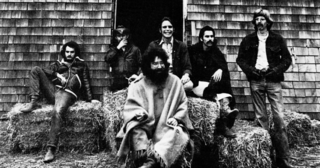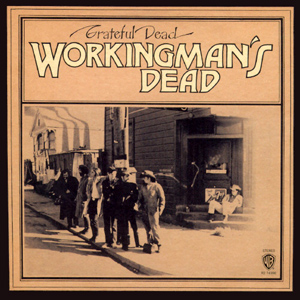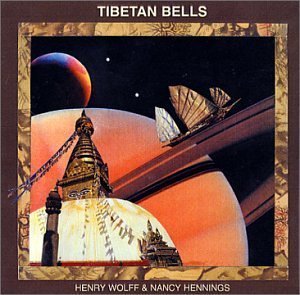
The Grateful Dead was an American rock band formed in 1965 in Palo Alto, California. The band is known for its eclectic style, which fused elements of rock, folk, country, jazz, bluegrass, blues, rock and roll, gospel, reggae, world music, and psychedelia; for live performances of lengthy instrumental jams that typically incorporated modal and tonal improvisation; and for its devoted fan base, known as "Deadheads". "Their music", writes Lenny Kaye, "touches on ground that most other groups don't even know exists." These various influences were distilled into a diverse and psychedelic whole that made the Grateful Dead "the pioneering Godfathers of the jam band world". The band was ranked 57th by Rolling Stone magazine in its "The Greatest Artists of All Time" issue. The band was inducted into the Rock and Roll Hall of Fame in 1994 and a recording of their May 8, 1977 performance at Cornell University's Barton Hall was added to the National Recording Registry of the Library of Congress in 2012. Despite having only one top-40 single in their 30-year career, "Touch of Grey", the Grateful Dead remained among the highest grossing American touring acts for multiple decades and gained a committed fanbase by word of mouth and the exchange of live recordings due to the band's permissive stance on taping.

Mickey Hart is an American percussionist. He is best known as one of the two drummers of the rock band Grateful Dead. He was a member of the Grateful Dead from September 1967 until February 1971, and again from October 1974 until their final show in July 1995. He and fellow Dead drummer Bill Kreutzmann earned the nickname "the rhythm devils".
Psychedelic rock is a rock music genre that is inspired, influenced, or representative of psychedelic culture, which is centered on perception-altering hallucinogenic drugs. The music incorporated new electronic sound effects and recording techniques, extended instrumental solos, and improvisation. Many psychedelic groups differ in style, and the label is often applied spuriously.
Country rock is a subgenre of popular music, formed from the fusion of rock and country. It was developed by rock musicians who began to record country-flavored records in the late 1960s and early 1970s. These musicians recorded rock records using country themes, vocal styles, and additional instrumentation, most characteristically pedal steel guitars. Country rock began with artists like Buffalo Springfield, Michael Nesmith, Bob Dylan, Nitty Gritty Dirt Band, the Byrds, the Flying Burrito Brothers, The International Submarine Band and others, reaching its greatest popularity in the 1970s with artists such as Emmylou Harris, the Eagles, Linda Ronstadt, Michael Nesmith, Poco, Charlie Daniels Band, and Pure Prairie League. Country rock also influenced artists in other genres, including the Band, the Grateful Dead, Creedence Clearwater Revival, the Rolling Stones, and George Harrison's solo work, as well as playing a part in the development of Southern rock.
Alternative country, or alternative country rock, is a loosely defined subgenre of country music and/or country rock that includes acts that differ significantly in style from mainstream country music, mainstream country rock, and country pop. Alternative country artists are often influenced by alternative rock. Most frequently, the term has been used to describe certain country music and country rock bands and artists that are also defined as or have incorporated influences from alternative rock, heartland rock, Southern rock, progressive country, outlaw country, neotraditional country, Texas country, Red Dirt, honky-tonk, bluegrass, rockabilly, psychobilly, roots rock, indie rock, hard rock, folk revival, indie folk, folk rock, folk punk, punk rock, cowpunk, blues punk, blues rock, emocore, post-hardcore, and rhythm 'n' blues.

American Beauty is the fifth studio album by rock band the Grateful Dead. Released November 1, 1970, by Warner Bros. Records, the album continued the folk rock and country music style of their previous album Workingman's Dead, issued earlier in the year.

Robert C. Christie Hunter was an American lyricist, singer-songwriter, translator, and poet, best known for his work with the Grateful Dead. Born near San Luis Obispo, California, Hunter spent some time in his childhood in foster homes, as a result of his father's abandoning his family, and took refuge in reading and writing. He attended the University of Connecticut for a year before returning to Palo Alto, where he became friends with Jerry Garcia. Garcia and Hunter began a collaboration that lasted through the remainder of Garcia's life.

Music of China refers to the music of the Chinese people, which may be the music of the Han Chinese in the course of Chinese history as well as ethnic minorities in today's China. It also includes music produced by people of Chinese origin in some territories outside mainland China using traditional Chinese instruments or in the Chinese language. It includes forms from the traditional and modern, Western inspired, commercial popular music, folk, art, and classical forms, and innovative combinations of them.
Ned Lagin is an American artist, photographer, scientist, composer, and keyboardist.

Workingman's Dead is the fourth studio album by American rock band Grateful Dead. It was recorded in February 1970 and originally released on June 14, 1970. The album and its studio follow-up, American Beauty, were recorded back-to-back using a similar style, eschewing the psychedelic experimentation of previous albums in favor of Jerry Garcia and Robert Hunter's Americana-styled songcraft.

Tibetan Bells is a 1972 album by Henry Wolff and Nancy Hennings. It was the first recording to use Tibetan bells and singing bowls, and helped establish some of the fundamentals of new-age music.

John Bush Shinn III was an American country music singer, songwriter, and musician. Nicknamed the "Country Caruso", Bush was best known for his distinctive voice and for writing the song "Whiskey River", a top 10 hit for himself which also became the signature song of fellow country artist Willie Nelson. He was especially popular in his native Texas.
Roots rock is a genre of rock music that looks back to rock's origins in folk, blues and country music. It is particularly associated with the creation of hybrid subgenres from the later 1960s including blues rock, country rock, Southern rock, and swamp rock which have been seen as responses to the perceived excesses of dominant psychedelic and developing progressive rock. Because roots music (Americana) is often used to mean folk and world musical forms, roots rock is sometimes used in a broad sense to describe any rock music that incorporates elements of this music. In the 1980s, roots rock enjoyed a revival in response to trends in punk rock, new wave, and heavy metal music.

The music of Tibet reflects the cultural heritage of the trans-Himalayan region centered in Tibet, but also known wherever ethnic Tibetan groups are found in Nepal, Bhutan, India and further abroad. The religious music of Tibet reflects the profound influence of Tibetan Buddhism on the culture.

A standing bell or resting bell is an inverted bell, supported from below with the rim uppermost. Such bells are normally bowl-shaped, and exist in a wide range of sizes, from a few centimetres to a metre in diameter. They are often played by striking, but some—known as singing bowls—may also be played by rotating a mallet around the outside rim to produce a sustained musical note.

Aoxomoxoa is the third studio album by the Grateful Dead. One of the first rock albums to be recorded using 16-track technology, fans and critics alike consider this era to be the band's experimental apex. The title is a meaningless palindrome, usually pronounced.

Europe '72 is a live triple album by the Grateful Dead, released in November 1972. It covers the band's tour of Western Europe in April and May that year, and showcases live favourites, extended improvisations and several new songs including "Jack Straw" and "Brown Eyed Women". The album was the first to include pianist Keith Godchaux and his wife, vocalist Donna Jean Godchaux, and the last to feature founding member Ron "Pigpen" McKernan, who died shortly after its release.

Rose Colored Glasses is the 1978 debut album by country music artist John Conlee. It was released on ABC Records, and was his only disc for the label; he would move to MCA Records the next year.
Betty Cantor-Jackson is an American audio engineer and producer. She is best known for her work recording live concerts for the Grateful Dead from the late 1960s to the early 1980s, including the Cornell 5/8/77 album. She is noted for her ear for recording and her long tenure with the band.

Yamantaka is an album by percussionist Mickey Hart and Tibetan bell specialists Henry Wolff and Nancy Hennings, best known for their 1972 release Tibetan Bells. Yamantaka was recorded in California in 1982, and was initially released on LP in 1983 by Celestial Harmonies. The album, which features performances on rare and invented percussion instruments, was reissued on CD in 1991 with three additional tracks that were recorded earlier that year in Connecticut, and was included in the five-CD boxed set The Complete Tibetan Bells (1972–1991). Musicians Jody Diamond, Sandy Sawyer, and Brian Keane, who produced the reissued album, also appear on several tracks.













